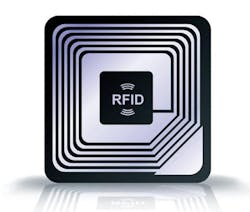Frying pans, pill bottles, canes, coffee cups, and countless other nonelectronic objects could be turned into a network of Internet of Things sensors with a new RFID-based technology from the University of Michigan. The system, called IDAct, bridges the gap between the estimated 14.2 billion “smart” electronic devices currently thought by some to be part of the IoT and the hundreds of billions of everyday “stupid” objects left out of the picture.
UM researchers say it’s a key step toward creating an immersive IoT experience. “Imagine a world where your pill bottle track your medication intake and a water glass monitors your hydration levels,” says engineering professor Alanson Sample. “Even your yoga mat is aware of your exercises and could adjust lighting, temperature, and background music accordingly.”
The technology also has potential applications in geriatric care, where it could unobtrusively monitor medications and daily activities—helping seniors stay independent longer without the need for expensive and invasive live-in care.
Using RFID readers and battery-free RFID tags that cost only a few cents, IDAct senses the presence and movement of people in a room and detects the movement of objects with enough detail to determine, for example, whether you’ve moved a pill bottle or cooked a meal. The tags can be attached to nearly any object in the form of a sticker, and RFID readers can be built into everyday objects such as light bulbs.
“Given the ubiquity of these objects, there are significant opportunities for improving their sensing capabilities and creating interactive applications around them,” says computer science professor Hanchuan Li. RFID tags using IDAct correctly identified specific activities more than 96% of the time in a recent study.
The technology could lead to tools that help the elderly and ill stay in their own homes longer by monitoring their daily activities. It could detect changes in eating, sleeping, or medication, for example, before the situation deteriorates and they end up in the emergency room.
RFID tags have been used for years to track objects in shipping and theft prevention programs. The tags absorb just enough electromagnetic energy from the reader’s signal to broadcast a simple, unique code. In the past, the reader simply picked up this code to identify whether the object was present or not.
IDAct improves on this by providing a more nuanced reading of RFID tags’ signals. It detects minute fluctuations in signals coming from tags to detect when an object is moved or whether a person is touching it. It can also detect changes in a room’s electromagnetic field to infer, for example, when a human is present.
“Every object causes electromagnetic interference in a specific way,” Sample says. “We can use that information, along with information from RFID tags, to get detailed pictures of what’s going on.”
These improved signals are analyzed by a machine learning algorithm run by an onsite computer to infer what’s happening in a room. In the testing phase, this processing was done on a laptop, but Sample envisions the necessary hardware eventually will be built into the RFID reader.
The team tested the technology by outfitting a volunteer’s apartment with a series of RFID readers and then put RFID tags on household objects. The researchers collected 26 hours of data from each room while users were present, and also collected two hours of data from empty rooms as a control.
The team will now look for industry partners that could build out the technology for use in elder care settings.


